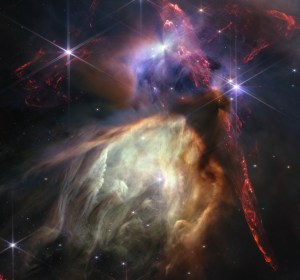Cassini is currently orbiting Saturn with a period of 12.9 days in a plane inclined 1.3 degrees from the planet's equatorial plane. The most recent spacecraft tracking and telemetry data were obtained on Jan. 6 using the 70-meter diameter Deep Space Network station in California. The spacecraft continues to be in an excellent state of health with all of its subsystems operating normally except for the instrument issues described at http://saturn.jpl.nasa.gov/news/significantevents/anomalies .
Commands from the on-board sequence S92 controlled Cassini's activities this week, while the Sequence Implementation Team members continued working on the ten-week command sequences S93, S94, and S95. The latter will have control of the spacecraft through Sept. 8 of this year.
Wednesday, Dec. 30 (DOY 364)
Cassini's Imaging Science Subsystem (ISS) led an observation of Saturn's largest moon Titan for 90 minutes today, studying its atmosphere from a distance of 1.5 million kilometers. The Composite Infrared Spectrometer (CIRS) and the Visible and Infrared Mapping Spectrometer (VIMS) participated as well. ISS then had the spacecraft turn to point the instruments near Saturn for a satellite orbit campaign observation, which took one hour. Next, ISS and VIMS looked over to the planet for a two-minute Saturn storm-watch observation.
At the conclusion of these telescopic observations, Cassini's Magnetospheric Imaging Instrument (MIMI) took the reins and had the spacecraft roll for 12 hours to study Saturn’s inner magnetosphere.
Thursday, Dec. 31 (DOY 365)
ISS conducted another Titan monitoring campaign observation with CIRS and VIMS; this one was from a distance of 1.1 million km that lasted two hours. The Cosmic Dust Analyzer (CDA) then started a series of observations to determine the composition of E-ring dust from about 180,000 km from Saturn outwards to the orbit of Titan, which is 1.2 million km out. The observations took place over the next two days, rocking the spacecraft back and forth to discriminate compositions of dust grains orbiting in varying inclinations. Totaling 43.3 hours of direct sampling, the observations were interrupted only by a few other short, planned science observations and engineering activities. The Magnetospheric and Plasma Science (MAPS) instruments were also taking high-priority data during this period, largely independent of the spacecraft's changing orientation.
Friday, Jan. 1 (DOY 001)
Happy periapsis! Today while Earthlings celebrated the start of 2016, Cassini passed the closest point to Saturn in its 13-day orbit. As it also happened, this was just a day before Earth reached its own periapsis to the Sun (perihelion) in its 365-day orbit. Cassini's periapsis brought it within 95,000 km above Saturn's visible limb, where it had reached a speed of 76,720 km per hour relative to the planet.
Saturday, Jan. 2 (DOY 002)
ISS made a three-hour observation of Saturn's small, icy moon Enceladus with CIRS, VIMS, and the Ultraviolet Imaging Spectrograph (UVIS) riding along. Enceladus was sunlit as a thin crescent, with its south-polar plume of ejecta lit up from behind; the viewing geometry is illustrated here.
Very infrequently the spacecraft, or one of its dozen scientific instruments, might need some attention in real time. During a Deep Space Network tracking and communications session today, telemetry showed that Cassini's magnetometer (MAG) had unexpectedly quit communicating with its spacecraft data-bus interface unit. After the flight team held an anomaly meeting, a quick realtime command was sent to reset the unit. This fixed the problem and returned MAG to normal operations. The longest part of the whole process was the round-trip communications time, three hours and two seconds at the speed of light.
Sunday, Jan. 3 (DOY 003)
ISS started the day with another 90-minute Titan cloud monitoring observation from a range of 1.4 million km. CIRS and VIMS rode along. During this time, MAG conducted an in-situ observation of the magnetic field.
Finally, CDA started another series of observations that would last 103.3 hours while Cassini coasted outbound towards a Jan. 7 apoapsis. These observations sample interstellar dust particles that encounter the instrument.
Monday, Jan. 4 (DOY 004)
An image featured today captures three of Saturn's icy moons while they were sunlit at a nearly half-moon phase. Two of them, Enceladus and Rhea, are readily apparent, but seeing the third one, Atlas, requires close study of the full-resolution image. Tiny Atlas orbits immediately outside of Saturn's A ring. The image is here: /resources/16292 .
Tuesday, Jan. 5 (DOY 005)
The Cassini science team members have listed their choices for Cassini's top 10 images and top 10 discoveries of 2015: .
https://solarsystem.nasa.gov/news/12889/cassini-top-10-science-highlights-2015/
In 330 days from now, Cassini will be starting its highly inclined F-ring orbits, during which periapsis will occur very close to that thin stranded ring just outside the main rings.
On five occasions during this week, the Deep Space Network communicated with and tracked Cassini, using stations in Australia and California. A total of 30 individual commands were uplinked, and about 1,826 megabytes of telemetry data were downlinked and captured at rates as high as 110,601 bits per second.
This illustration shows Cassini's position early on Jan. 5: http://go.nasa.gov/1jxy3x2 . The format shows Cassini's path over most of its current orbit up to today; looking down from the north, all depicted objects (except the background stars of course) revolve counter-clockwise, including Saturn along its orange-colored orbit of the Sun.
5 min read
Cassini Significant Events 12/30/15 – 01/05/16
Share
Details
Last Updated
Jan 24, 2024






























